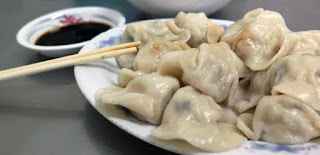What did you do on this year celebration? met big family ? collect red pocket? went for home town?
Good Morning readers, I would like to keep my promise to make updates
and now I want to share ...
12 Chinese New year Food full of luck from Travel China Guide and Chowhound
1. Dumpling
Dumplings are often eaten at the midnight. This kind of tradition has a meaning of changing of years, because “jiao” has the meaning of changing. There are two other reasons to eat dumplings: the dumpling’s shape resembles the Chinese tael, which hopes to bring in wealth and treasures in next year. The second reason is that the dumplings have stuffing, in which people often put auspicious materials inside. In some places, people even put a clean coin into the dumplings, because they think the one who eats the coin will become wealthier.
Nowadays, dumplings are the major food on the New Year's Eve and the first meal on the first and the fifth day of New Year.
2. Fish
Fish is an indispensable dish on the reunion dinner, because Chinese people give it many kinds of meanings. Fish has its Chinese pronunciation as ‘Yu’, which means having more than just a basic need each year. In southern China, some people just eat the middle part of the fish on the New Year Eve, leaving the head and tail to the next day to symbolize completeness. In China, there is a blessing speech as ‘Nian Nian You Yu’, which means ‘May you have surpluses and bountiful harvests every year.’
3. Long noodles
If noodles are served, then “keep them as long as possible for long life,”
4. Jai
This vegetarian dish is eaten because it’s “part of the Buddhist culture to cleanse yourself with vegetables,” says Lum. It’s also packed with good-luck foods, writes Gong, breaking it down by ingredient: sea moss for prosperity; lotus seeds for children/birth of sons; noodles for longevity; lily buds to “send 100 years of harmonious union”; Chinese black mushrooms to “fulfill wishes from east to west”; and more.
5. Long leaffy greens and long beans
leafy greens, such as Chinese broccoli, are “served whole to wish a long life for parents.”
6 Rice Dumpling
People in north and south of China have different eating habits and making processes of rice dumplings. In south part of the country, the rice dumplings are called Tangyuan in Chinese. The making process is similar with that of the traditional dumplings. Dough made by glutinous rice powder is made first and then use the dough to wrap the stuffing such as bean paste, brown sugar and all kinds of fruits and nuts. But in north part of the country, the rice dumplings are called Yuanxiao, and are made by wrapping glutinous rice flour onto stuffing. Fillings are madefirst; then flour is put into a bamboo basket and then fillings into the basket. Shaking the basket, the flour can stick to the fillings, so that the rice dumplings can be finished.
7 Nian Gao ( New Year Cake )
“Nian gao means year cake, but gao sounds the same as the word for tall or high,” says Dunlop. Hence the cakes symbolize achieving new heights in the coming year. The steamed sweets are made of glutinous rice flour, brown sugar, and oil. Some versions have white sesame seeds, red dates, or nuts in them (the dates are said to bring “early prosperity,” writes Gong in Good Luck Life).
8 Spring rolls
Fresh vegetables or ingredients in spring time are wrapped inside and people eat it to welcome a new spring. Now it has also become a dessert in some places in the reunion dinner, which contain people’s wish to welcome a new start.
9 The Tray of Togetherness
Put out for visiting relatives to snack on, or given as a gift, the eight (“a traditionally symbolic lucky number,” explains Dunlop) compartments of the tray are filled with things such as preserved kumquats for prosperity, coconut for togetherness, longans to bring many sons, and red melon seeds for happiness.
10 Pomelo
This large citrus fruit is popular, writes Gong, because it is thought to bring “continuous prosperity and status.” The tradition comes from the way the Cantonese phrase forpomelo sounds similar to the words for prosperity and status, explains Lum.
11 Tangerins and Oranges
According to the Chinese Culture Center of San Francisco, the tradition stems from the way the Chinese words for gold and orange sound alike, while the word for tangerine echoes luck. “It’s good if they have leaves,” adds Lum, “because leaves symbolize longevity.” But don’t group them in fours, because, Dunlop says, this number is associated with death.
12 Sweets
Serving desserts brings a sweet life in the new year. Gong writes that a childhood favorite was the flaky cookie pockets called gok jai, filled with peanuts, coconut, and sesame.
Thank you readers, hope you will get more full of luck for next and the next day.
Reference:
http://www.chowhound.com/food-news/54874/14-good-luck-foods-for-chinese-new-year/
http://www.travelchinaguide.com/essential/holidays/new-year/food.htm
.












Tidak ada komentar:
Posting Komentar
Catatan: Hanya anggota dari blog ini yang dapat mengirim komentar.